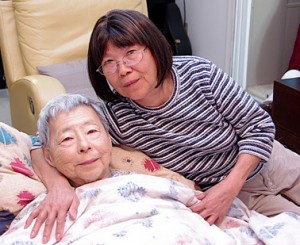Family caregivers in US face emotional, financial strain, says study
WASHINGTON, DC – Typical family caregivers in America are changing as the population ages, are becoming as diverse as the American population and facing not only emotional but also financial strain, according to a new research study from the National Alliance for Caregiving and AARP.
Caregiving in the U.S. 2015 provides surprising insight into today’s family caregivers. The typical higher-hour caregiver (who provides unpaid care for at least 21 hours a week) has been caregiving for an average of 5-1/2 years and expects to continue care for another five years. Nearly half of these higher-hour caregivers report high emotional stress (46 percent).

With an average household income of $45,700, caregivers report not only emotional strain, but also financial strain. Higher-hour caregivers report difficulty in finding affordable caregiving services, such as delivered meals, transportation, or in-home health services, in the community for them and their loved ones.
Financisl strains
Caregivers who live more than an hour away from their care recipient also report higher levels of financial strain (21 percent), perhaps because 4 out of 10 long-distance caregivers report the use of paid help (41 percent).
Also surprising are findings from subpopulations of caregivers. Today, nearly a quarter of America’s caregivers are millennials between the ages of 18 and 34 and are equally likely to be male or female.
On the other end of the spectrum, caregivers ages 75 or older are typically the sole support for their loved one, providing care without paid help or help from relatives and friends. Men, a group often stereotyped as failing to take on caregiving responsibilities, currently represent 40 percent of family caregivers and provide an average of 23 hours a week supporting a loved one.
“We’re especially concerned that not enough is being done to support family caregivers in the public or private sector as they age,” explained Gail Gibson Hunt, president and CEO of the National Alliance for Caregiving. “There’s a double-edged sword when we fail to support caregivers, because we put both the caregiver and the care recipient at risk.”
Caregivers of a close relative—like a spouse or a parent—who are likely to provide care for 21 hours or more, indicate that being noted as a family caregiver in the medical records of the care recipient would be helpful in managing their caregiving responsibilities.
Managing stress
Other desired supports include respite care, as well as access to resources and tools to assist the caregiver with managing stress and to enable the care recipient to live at home.
“As previous AARP research has shown, we’re facing a caregiving cliff,” said Dr. Susan Reinhard, senior vice president and director, AARP Public Policy Institute; and chief strategist, Center to Champion Nursing in America. “By mid-century, there will be only three family caregivers available for each person requiring care. That means, to avoid putting them at higher risk as they age, we need to provide support for existing caregivers who are underserved by the current long-term services and support system.”
Caregiving in the U.S. 2015 is a joint report between the National Alliance for Caregiving and AARP. The report was made possible through sponsorship from AARP, the Archstone Foundation, Eli Lilly, Home Instead Senior Care, the MetLife Foundation, Pfizer, UnitedHealthcare and the Family Support Research and Training Center in conjunction with the University of Illinois at Chicago.
Highlights of Today’s Caregivers:
- 82% care for one person who is likely either living with the caregiver or living within 20 minutes of the caregiver.
- 60% of caregivers are female. The typical caregiver is a 49-year-old female caring for a 69-year-old female relative, most likely her mother.
- 40% of caregivers are male.
- 34% of caregivers have a full-time job, while 25% work part time. Caregivers who work do so for 34.7 hours per week on average.
- Caregivers have been caring for 4 years on average, spending 24.4 hours per week helping with activities like bathing, dressing, housework, and managing finances.
- 32% provide at least 21 hours of care a week, on average providing 62.2 hours of care weekly.
- 38% of caregivers report high emotional stress from the demands of caregiving.
Visit https://www.caregiving.org/caregiving2015/ or https://www.aarp.org/caregivingintheus/ to download the report and related materials. - Like us on Facebook














